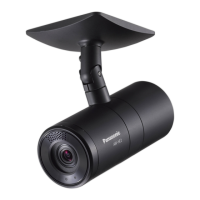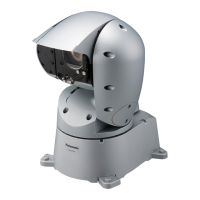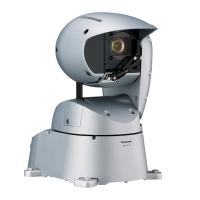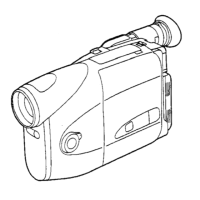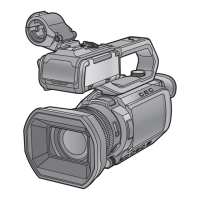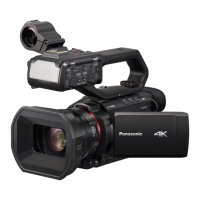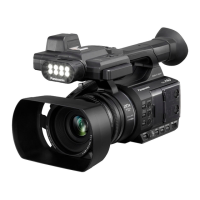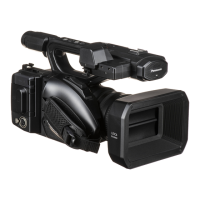Do you have a question about the Panasonic AW-E600 and is the answer not in the manual?
Lists actions to avoid to prevent damage or risk.
Lists recommended actions for proper handling and maintenance.
Procedure for attaching a lens to the camera securely.
Steps for mounting the camera using an adaptor or bracket.
How to connect devices using the composite video output.
Guide for connecting the camera to a Remote Control Unit (RCU).
Instructions for connecting the camera to a Remote Control Box (RCB).
Connecting camera with pan/tilt units and control panels.
Setting up multiple cameras for color lock synchronization.
How to remotely control the camera using a computer.
Automatic adjustment of white balance based on light conditions.
Real-time white balance adjustment following light changes.
Procedures for manually setting white balance via camera or RCU.
Resetting white balance to specific preset color temperatures.
Procedure for adjusting the camera's black balance.
Adjusting black levels across multiple cameras for consistency.
Adjusting horizontal phase for synchronization with external signals.
Adjusting color phase for accurate color reproduction and synchronization.
How to select and set the camera's operational use mode directly.
Selecting operational modes using remote control units.
Overview of the main menu structure and its items.
Adjusting the overall picture level for video output.
Adjusting the ratio of peak to average detection for auto controls.
Selecting measurement areas for photometric controls like auto iris.
Controlling electronic shutter for automatic luminance adjustment.
Adjusting automatic gain for low light conditions.
Manually setting gain levels for specific shooting scenarios.
Adjusting the black level (pedestal) of the luminance signal.
Adjusting the contrast or gamma of the video signal.
Adjusting the saturation of the color signal.
Fine-tuning skin tones for natural appearance.
Options for setting and storing white balance presets.
Adjusting highlight chroma to prevent clipping of bright colors.
Adjusting horizontal phase for synchronization with external signals.
Coarse adjustment of subcarrier phase for genlock.
Fine adjustment of subcarrier phase for genlock.
Setting the level for the color bar signal.
Selecting contour correction type (Sharpness or Super DTL).
Adjusting noise reduction levels for screen noise.
Selecting the Digital Noise Reduction effect.
Adjusting detail levels specifically for skin tones.
Controls for the electronic shutter speed and modes.
Setting for reducing horizontal bar noise in specific scenes.
Selecting the CCD read-out mode (Field or Frame).
Setting communication speed for computer control.
Choosing between normal and reversed image output.
Method for adjusting settings directly on the camera.
Method for adjusting settings using the RCU (RCB).
Adjusting the overall picture level for video output.
Adjusting the ratio of peak to average detection for auto controls.
Selecting measurement areas for photometric controls like auto iris.
Fine-tuning the auto iris level using the iris control.
Controls for the electronic shutter speed and modes.
Selecting specific shutter speeds for the electronic shutter.
Setting for reducing horizontal bar noise in specific scenes.
Selecting the CCD read-out mode (Field or Frame).
Options for Automatic Gain Control (AGC) and Night Eye.
Adjusting the black level (pedestal) of the luminance signal.
Adjusting the saturation of the color signal.
Options for setting and storing white balance presets.
Adjusting highlight chroma to prevent clipping of bright colors.
Adjusting R/B gain and pedestal for fine color and black balance tuning.
Adjusting color matrix levels for accurate color reproduction.
Adjusting the gamma curve for contrast and tone reproduction.
Setting knee compensation for peak video signal levels.
Setting the peak level for white clipping.
Adjusting the level of flare correction.
Enabling or disabling black stretch for low luminance detail.
Selecting the Digital Noise Reduction effect.
Setting communication speed for computer control.
Choosing between normal and reversed image output.
Adjusting noise reduction compensation for sharp detail.
Reducing screen noise in dark image areas.
Emphasizing contours in darker portions of an image.
Emphasizing contours in high-hue portions of an image.
Adjusting detail levels specifically for skin tones.
Improving resolution and detail at the edges of the image.
Narrowing detail width and suppressing glare.
| Zoom | 20x optical zoom |
|---|---|
| Focus | Auto/Manual |
| Operating Temperature | 0°C to 40°C (32°F to 104°F) |
| Shutter Speed | 1/60 - 1/2000 sec |
| Gain | 0dB, +3dB, +6dB, +9dB, +12dB, +18dB |
| White Balance | Auto/Manual |
| Video Output | HDMI |
| Audio Input | XLR x 2 |
| Power Supply | AC 100V to 240V, 50/60Hz |
| Video Resolution | 1920 x 1080 |
| Audio Recording Format | Linear PCM |
